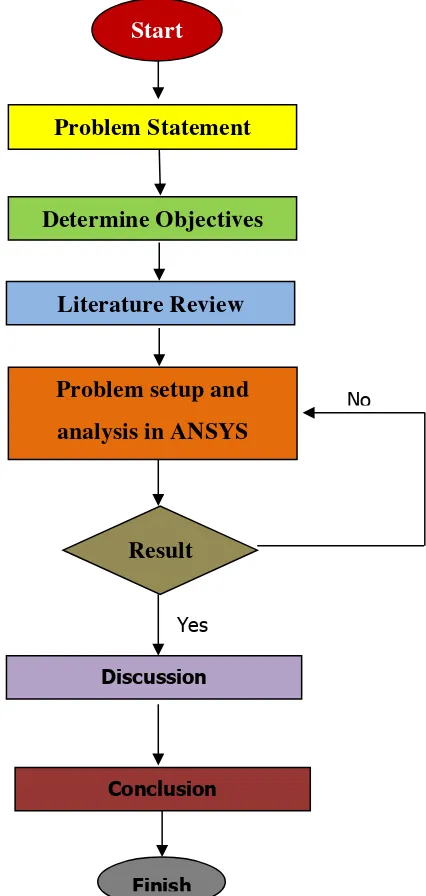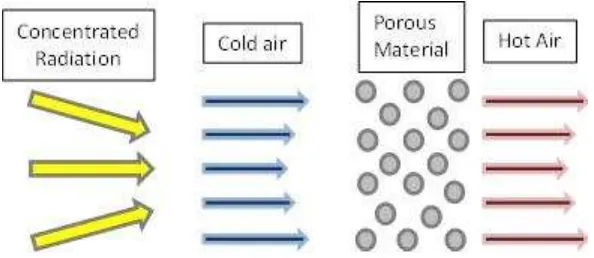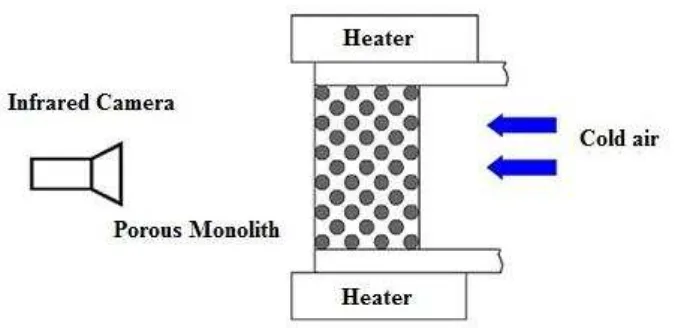SUPERVISOR DECLARATION
“I hereby declare that I have read this thesis and in my opinion this report is sufficient in terms of scope and quality for the award of the degree of
Bachelor of Mechanical Engineering (Thermal-Fluids)”
Signature:
Supervisor: ABDUL RAFEQ BIN SALEMAN
THE HEAT TRANSFER PHENOMENON WITHIN VOLUMETRIC RECEIVER OF CONCENTRATED SOLAR TOWER USING DIAMOND
LIKE CARBON (DLC) MATERIAL
SITI SARAH BT ZAHARI
This report is presented in
partial fulfillment of the requirement for the
Degree of Bachelor of Mechanical Engineering (Thermal & Fluid)
Faculty of Mechanical Engineering Universiti Teknikal Malaysia Melaka
ii
DECLARATION
“I hereby declare that the work in this report is my own except for summaries and quotations which have been duly acknowledged.”
Signature:
Author: SITI SARAH BT ZAHARI
iii
Special for my beloved Father and Mother,
iv
ACKNOWLEDGEMENT
Assalamualaikum Warahmatullah Wbt.
In the name of Allah, the Most Gracious and the Most Merciful. Alhamdulillah, all praises to Allah for the strengths and His blessing in completing this Final Year Project.
Special appreciation to Universiti Teknikal Malaysia Melaka (UTeM) staffs for all the services throughout all four years of my studies and for providing all the facilities that beneficial for my studies. I would like to express my deepest gratitude to my supervisor, Mr. Fadhli Bin Syahrial for his guidance and encouragement during PSM I and Mr Abdul Rafeq Bin Saleman for his guidance and patience during PSM II as he is taking role of my supervisor for Mr. Fadhli due to he went to further his study in PhD.
On this occasion I also want to sincerely thank my best friend, Kismera Mohamed Amin for her understanding and morale support, my colleagues and all members from 4BMCT for their support either directly or indirectly.
v
ABSTRACT
vi
ABSTRAK
vii
TABLE OF CONTENTS
CHAPTER CONTENTS PAGES
DECLARATION ii
DEDICATION iii
ACKNOWLEDGEMENT iv
ABSTRACT v
ABSTRAK vi
TABLE OF CONTENTS vii
LIST OF TABLES ix
LIST OF FIGURES x
LIST OF SYMBOL xii
LIST OF APPENDICES xiii
CHAPTER I
INTRODUCTION 1
1.1 Background 1
1.2 Problem Statement 4
1.3 Objective 4
1.4 Scope 5
1.5 Project Flow 5
CHAPTER II
LITERATURE REVIEW 7
2.1 Volumetric Receiver 7
viii
CHAPTER CONTENTS PAGES
CHAPTER III
RESEARCH METHODOLOGY 19
3.1 Introduction 19
3.2 Problem Specification 19
3.3 Mesh Generation 22
3.4 Grid Independence Test 23
3.5 Flow And Heat Transfer Modeling 25
3.6 Boundary Condition 27
3.7 DLC Receiver Properties 27
3.8 Simulation Flow 27
CHAPTER IV
RESULT AND ANALYSIS 29
4.1 Model Validation 30
4.2 DLC Thermal Conductivity 20W/m.K 32
4.3 DLC Thermal Conductivity 3000W/m.K 33
4.3.1 Porosity 0.7, Mean Cell Size 1.35mm 33 4.3.2 Porosity 0.7, Mean Cell Size 1.55mm 35 4.3.3 Porosity, 0.7, Mean Cell Size 3.5mm 37
4.4 Discussion 39
CHAPTER V
CONCLUSION AND RECOMMENDATION 40
5.1 Conclusion 40
5.2 Recommendation 42
REFERENCES 43
BIBLIOGRAPHY 47
ix
LIST OF TABLES
NO. TITLE PAGES
2.1 Several properties of DLC 18
3.1 No of nodes and elements for different relevance of meshing
23
4.1 Properties of DLC with thermal conductivity 20W/m.K 29 4.2 Properties of DLC with thermal conductivity
3000W/m.K
x
LIST OF FIGURES
NO. TITLE PAGES
1.1 Central receiver system with a solar tower absorber 3
1.2 Flow chart of research activities 6
2.1 Cold air was heated by heat transfer between air and hot porous surface that irradiated
8
2.2 Experimental set up for investigating the flow instability by monitoring temperature distribution
9
2.3 The hot spot matrix presented result of 12 combination properties of porous medium
11
2.4 sp3 bond in diamond structure 14
2.5 sp2 bond in graphite structure 15
2.6 Diamond like carbon structure with sp3 and sp2 bonds 15 2.7 The setup for synthesis of DLC by in liquid microwave
plasma CVD
17
3.1 Volumetric receiver module 20
3.2 Schematic figure of problem specification 20
3.3 The model used in Fluent simulation 21
3.4 Grid used in simulation 22
3.5 Velocity profile for fine, medium and coarse meshing 24
3.6 Project simulation flow 28
4.1 Simulation result based on parameters set as Becker, M. et al.
31
4.2 Hot spot maintained/vanished at final result according to Becker et al.
xi
NO. TITLE PAGES
4.3 The temperature contour for receiver of thermal conductivity 20W/m.K
32
4.4 The initiated hot spot for mean cell size 1.35mm model 33 4.5 Final result after calculation continued with
homogenous heat flux
34
4.6 The inlet (blue block) and outlet (yellow block) temperature
34
4.7 The initiated hot spot for DLC receiver of mean cell size 1.55 mm
35
4.8 Final result 35
4.9 Inlet and outlet temperature result 36
4.10 The hot spot initiated on module surface 37
4.11 The final result which the hot spot vanish 37
4.12 The inlet temperature (blue) and outlet temperature (yellow)
xii
LIST OF SYMBOL
kW = kilowatt (103 Watt) MW = megawatt (106 Watt) EJ = Exa Joule (1018 Joule)
λeff = Effective Thermal Conductivity λf = Fluid Thermal Conductivity λs = Solid Thermal Conductivity
= Porosity
K1 = Viscous coefficient K2 = Inertial coefficient
= Fluid viscosity
= Fluid density
= Velocity
= Mean cell size (m) = Heat transfer coefficient
= Surface temperature = Fluid temperature
= Interfacial area density (m2/m3)
= Local volumetric Nusselt Number
= Hydraulic diameter Q = Heat transfer rate
= Surface area
= Temperature difference
xiii
LIST OF APPENDICES
NO TITLE PAGES
1 Gantt chart 48
2 Table of heat transfer coefficient value for certain range of thermal conductivity
1
CHAPTER I
INTRODUCTION
1.1 BACKGROUND
Technology is advancing year by year and development is rapidly growing, resulting increased in energy demands. Nevertheless, current energy resources which is fossil fuels will soon depleted, in which making the development not sustainable anymore with this trending, there will be one point in which the power production would not be able to meet the energy demands. Therefore, alternatives resources aside from fossil fuels were researched extensively by scientists and researchers.
2
Sun from solar system emits energy in the form of photon at a rate of 38x1023 kW. However, due to distance between Earth and Sun which is too far, only about 1.8x1014 kW will be seized by the Earth, but only 60% of the figure will reach the earth surface. Nevertheless, with only 0.1% of this energy would be enough to generate power which is 7500 times larger than the world total primary consumption of 450 EJ. The energy contained within solar radiation is very large that it succeeded even the combination of all the estimated non-renewable energy resources including fossil fuels and nuclear energy (Goswami, 2010).
The abundant energy within solar can be harness to generate electricity by either solar photovoltaic or solar thermal. Electricity generated by petrochemical effect in solar photovoltaic application. The energy contained within the photons of solar radiation absorbed by the p-n material of PV cells and electron released by the n materials in which the electron was carried to p-junction and thus produces electricity (Twidell and Weir, 2006).
3
Solar tower absorber operating principles varies from each other, basically categorized into three; tube receiver, volumetric receiver and dual receiver (Kretzshmar, 2012). However volumetric receiver such as in Figure 1.2 is one that mostly studied for its potential of being able to absorb more radiation in the volume of material due to the porosity (Fend, 2010).
Figure 1.1 is the Solar Two project, a concentrated solar tower with central receiver power plant which the major components consist of heliostat, solar tower absorber, and turbo machineries coupled with electric generator. The operating principle of major component of central concentrated power plant is:
1) Heliostats
Heliostats are a field of mirrors that attached to tracking devices and able to move about two axes throughout the day in order to track sun and keep radiation reflected to the centre of receiver (Stine and Geyer, 2001).
2) Solar tower absorber
Solar tower absorber functions by transferring energy from incoming reflected solar radiation to the working fluid that will run the turbine and generates electricity.
Figure 1.1: Central receiver system with a solar tower absorber
4
1.2 PROBLEM STATEMENT
Solar tower absorber operating principles varies from each other, basically categorized into three; tube receiver, volumetric receiver and dual receiver. However volumetric receiver is one that mostly studied for its potential of being able to absorb more radiation in the volume of material due to the porosity. Since the volumetric receiver principally absorbing the solar radiation reflected by heliostats, the material that builds the structure should have good absorptivity and conductivity while be able to withstand high operating temperature of above 800˚C. From literature, most plant used ceramics such as Silicon Carbide (SiC) as absorber. However, it was identified that there are few problems encounter using ceramic as an absorber, in which it tend to melt due to local overheating of material in the event of inhomogeneous flux distributions and flow instability which in some cases lead to formation of hot spots because of the material is unable to spread the heat to all volume in short period of time. Therefore the aim of this study is to replace the current absorber with Diamond Like Carbon (DLC) which has higher thermal conductivity and is more durable to high temperature condition.
1.2 OBJECTIVE
At the end of this project, following is the objective anticipated to be accomplished:
5
1.3 SCOPES
This project is focusing on the absorber part of concentrated solar tower, which the absorber is volumetric receiver type. In this research, the applicability of DLC as the material of volumetric receiver was investigated and in order to accomplish this aim, the scope of study has been determined to focus on:
1) 3D Simulation of heat transfer between air and porous medium across the absorber using ANSYS Fluent.
2) Analyze the outlet temperature and temperature distribution across the absorber module.
3) Analyze formation of hot spots.
1.4 PROJECT FLOW
The first part of this final year project was conducted by reviewing on volumetric receiver and DLC related literatures. The literature that studied are related to numerical simulation of volumetric receivers, the formation of hot spots on volumetric receiver fronts, operating principle of the receivers and DLC properties. Literature review activity was conducted throughout the duration of final year project.
6
Figure 1.2 is the project flow which started with problem statement and determining project objective. Based on the objective and work scope, literature review was performed and then the problem was setup and analyzed using ANSYS Fluent. The result from analysis was further discussed and conclusion will be made based on the achievement of this project objective. After that, all the project process, result and discussion documented and the report submitted signifying the end of final year project. The Gantt chart of project schedule was attached as Appendix 1 in appendix section.
Start
Problem Statement
Determine Objectives
Literature Review
Result Problem setup and analysis in ANSYS
No
Yes
Finish Conclusion Discussion
7
CHAPTER II
LITERATURE REVIEW
2.1 VOLUMETRIC RECEIVER
Avila-Marin (2011) discussed on three things regarding volumetric receiver; i) he grouped and divided the type of volumetric receiver into four; pressurized receivers with metal absorber, pressurized receiver with ceramic absorber, open receiver with metal absorber and open receiver with ceramic absorbers such as HITREC Project ii) absorber materials and iii) the operating principles.
8
By referring to Figure 2.1, the operating principles of a volumetric receiver as according to Avila-Marin (Avila-Marin, 2011) are:-
1) Volumetric receiver is a combination of varying interlocking shapes, foam arrangement that made of metal, ceramic or other adequate materials with a specific porosity and installed in a volume inside the receiver so the solar radiation is absorbed in the depth of the structure.
2) The concentrated solar radiation heats the material in the volume and at the same time working fluid, usually air passes through the volume is heated up by forced convection transforming solar energy to thermal energy.
3) Heat is transferred to the working fluid at the surface which is heated up by the incoming radiation.
4) Finally, the volumetric effect causes the temperature of irradiated surface to become lower than the outlet temperature.
Figure 2.1: Cold air was heated by heat transfer between air and hot
porous surface that irradiated
Several paper have studied about pressure drop in the porous structure of volumetric receiver Wu et al. (Wu et al., 2010, 2011), Incerra et al. (Incerra et al.,
2008) and Lacroix (Lacroix, 2007). Wu et al. (Wu et al., 2010) in their paper had
9
Wu et al. (2010) performed the experimental studies on ceramic foams and ceramic foams with modified structure in which several holes with 2mm diameter were drilled uniformly in the foam specimen. At the end of the experiment, the modified foams have displayed good performance in the improvement of pressure drop and heat transfer. They conclude that it may due to the additional heat transfer provided by the mixing action of fluid in perpendicular direction, thanks to the pores drilled.
Fend et al. (2004a) and another researcher on the other hand in their paper mentioned about flow instabilities occurring in the porous structure of volumetric receiver. Fend et al. (2004a) have developed an experimental method to detect any occurrence of unstable flow which the experimental setup was as Figure 2.2. In the experiment, the front surface of sample recorded by an infrared camera. Referring to Figure 2.2, in the experiment the cylindrical sample was heated by tube heater while infrared camera installed in order to monitor the front surface temperature.
Figure 2.2: Experimental set up for investigating the flow instability by monitoring temperature distribution
10
The flow instabilities occurrence sparks interest to be researched since the flow instabilities have potential to formed hot spots on the receiver’s surface and cause material failure (Fend et al., 2004a). In the recent study (Fend, 2010), Fend’s
experiment results had shown a relationship that as the cell density increases, the efficiency also increased. However, the porous structure may cause flow instabilities within receiver of certain material in which the permeability of the material does not tolerate high viscosity air that increased due to temperature increases. In this event, the absorber material may melts even though the outlet air temperature has yet to reach the material’s melting point. Also suggested in his paper, this event may be avoided through a good effective thermal conductivity material applied, high inertial coefficient and the capability of material to mix the fluid throughout the structure.
The investigation of flow instability was explained in detail through Becker’s theoretical and numerical study on this phenomenon (Becker et al., 2006). The



